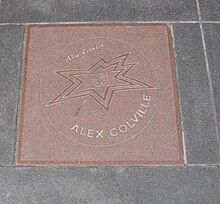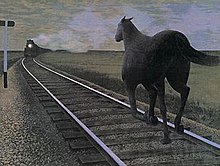Alex Colville
David Alexander Colville | |
|---|---|
 Alex Colville in 1945 | |
| Born | David Alexander Colville 24 August 1920 Toronto, Ontario, Canada |
| Died | 16 July 2013 (aged 92) Wolfville, Nova Scotia, Canada |
| Nationality | Canadian |
| Education | Mount Allison University |
| Known for | Painting |
| Spouse | Rhoda Wright (m 1942-2012(her death)) |
| Children | Graham Alexander Coville (1944-) Charles Wright Colville (1949-) Ann Christian Coville (1949-) John Harrower Coville (1946-2012) |
David Alexander Colville, PC CC ONS (24 August 1920 – 16 July 2013) was a Canadian painter.
Early life and war artist

Born in 1920 in Toronto, Ontario, Colville moved with his family at age seven to St. Catharines, and then to Amherst, Nova Scotia in 1929. He attended Mount Allison University from 1938 to 1942, graduating with a Bachelor of Fine Arts.[1]
He married Rhoda Wright in 1942 and enlisted in the Canadian Army in the infantry, eventually earning the rank of lieutenant. He painted in Yorkshire and took part in the Royal Canadian Navy's landings in southern France.[2] He was then attached to the 3rd Canadian Division. In the army for two years, and because he was a fine-arts student, he was made a war artist in May 1944.[3] His unit relieved the 82nd Airborne Division at Nijmegen, Netherlands in mid-September 1944 during Operation Market Garden and remained there until the following February.[3] He continued on to tours in the Netherlands and Germany, where he was also tasked with depicting the horrors of the Bergen-Belsen concentration camp.[2][4]
Career
Colville returned to New Brunswick after the war and became a faculty member with the Fine Arts Department at Mount Allison University where he taught from 1946 to 1963. He left teaching to devote himself to painting and print-making full-time from a studio in his home on York Street; this building is now named Colville House.
In 1966, works by Colville along with those of Yves Gaucher and Sorel Etrog represented Canada at the Venice Biennale.[5]
In 1967, Colville was made an Officer of the Order of Canada, elevated to Companion in 1982, the order's highest level.[6] He lived in St. Catharines, Ontario, for three years before moving to Nova Scotia. In 1973, he moved his family to his wife's hometown of Wolfville, where they lived and worked in the house that her father built and in which she was born. The Colvilles had three sons, a daughter, and eight grandchildren. In contrast to many of his contemporaries, Colville aligned himself with the Progressive Conservative Party of Canada and was a card-carrying party member for many years. In 1981 he was appointed university chancellor of Acadia University serving in that role until 1991.[7]
Death
Colville died on 16 July 2013 at his house in Wolfville at the age of 92 of a heart condition. His wife Rhoda Wright died on 29 December 2012. They are survived by three of their four children, Graham, Charles, and Ann. Their second son, John, died on 22 February 2012.
Exhibitions

Colville exhibited extensively across Canada and internationally including at the Tate Gallery in London and the Beijing Exhibition Centre in Beijing. In 1983 an international touring retrospective of his work was organized by the Art Gallery of Ontario.
Alex Colville's work is found in many collections including the Art Gallery of Nova Scotia, the Cape Breton University Art Gallery in Sydney, Nova Scotia, the New Brunswick Museum, Saint John, the Museum of Modern Art in New York, the Musée National d'Art Moderne in Paris, the National Gallery of Canada in Ottawa, the Centre National d'Art et de Culture Georges Pompidou in Paris, the Wallraf-Richartz Museum in Cologne and the Kestnergesellschaft in Hanover, Germany.
Notable works
"To Prince Edward Island"
This 1965[8] painting is perhaps his best-known work.[9] It features a woman depicted looking through binoculars, in the direction of the artist
"Horse and Train"

This 1954 work was inspired by two lines from the poet Roy Campbell:
- Against a regiment I oppose a brain
- And a dark horse against an armored train.
"Horse and Train" is a part of the Art Gallery of Hamilton's permanent collection; Dominion Foundries and Steel, Ltd. (Dofasco Inc) donated the painting in 1957. It appears on the cover of the album Night Vision by Bruce Cockburn. Alex Colville and "Horse and Train" are mentioned in the introduction (and in the story itself) of Nova Scotia fiction writer Barry Wood's short story Nowhere to Go published in England's Postscripts #14 in 2008. Reproduction at the wall in the film 'The Shining', position hallway, during doctors visit.
"The Circuit Rider"
His mural in Tweedie Hall at Mount Allison University, known officially as "The History of Mount Allison" or "The Circuit Rider".
"Pacific"
His 1967 painting "Pacific", showing a man leaning against an open door looking out to sea while a Browning Hi-Power pistol rests on a table in the foreground, inspired one of the definitive scenes in the 1995 film Heat with actor Robert De Niro.[10]
"Man on Verandah"
Painted in 1953, its sale at auction for $1.287 million set a record for a work by a living Canadian artist. Part of the estate of the late G. Hamilton Southam (1918–2008), it was sold at an auction of Canadian post-war and contemporary art by Heffel Fine Art Auction House on November 25, 2010. Expected to get up to $600,000, the price inflated during a three-way bidding war between two Canadian phone bidders and a person at the auction.[11]
"Infantry, near Nijmegen, Holland"

Trained as an infantry officer, he did a painting when World War II ended. Based upon numerous drawings, it was called "Infantry" and is now in the Canadian War Museum.[3] It represents a platoon of Canadian soldiers spread out and marching along both sides of a road. Colville believed it conveyed his perception of war, as both heroism and enduring persistence among nature's elements and constant danger.[3] The face of the first man is actually a portrait of the artist's father.
List of selected works
| Name | Year | Current Location |
|---|---|---|
| Infantry, near Nijmegen, Holland | 1946 | Canadian War Museum, Ottawa, Ontario, Canada |
| The History of Mount Allison (The Circuit Rider) | 1948 | Mount Allison University in Tweedie Hall, Sackville, New Brunswick, Canada |
| Nude and Dummy | 1950 | New Brunswick Museum, St John, New Brunswick, Canada |
| Man on Verandah | 1953 | Private collection, Germany |
| Horse and Train | 1954 | Art Gallery of Hamilton, Hamilton, Ontario, Canada |
| Family and Rainstorm | 1955 | Museum of Modern Art, New York City, New York, USA |
| Couple on Beach | 1957 | National Gallery of Canada, Ottawa, Ontario, Canada |
| Ocean Limited | 1962 | Art Gallery of Nova Scotia, Halifax, Nova Scotia, Canada |
| Skater | 1964 | Museum of Modern Art, New York City, New York, USA |
| To Prince Edward Island | 1965 | National Gallery of Canada, Ottawa, Ontario, Canada |
| Pacific | 1967 | Art Gallery of Ontario, Toronto, Ontario, Canada |
| Dog and Priest | 1978 | Art Gallery of Ontario, Toronto, Ontario, Canada |
| Target Pistol and Man | 1980 | Art Gallery of Ontario, Toronto, Ontario, Canada |
| Cyclist and Crow | 1981 | Montreal Museum of Fine Arts, Montreal, Quebec, Canada |
| Black Cat | 1996 | Mount Allison University in Owens Art Gallery, Sackville, New Brunswick, Canada |
| Waterville | 2003 | Private collection, Canada |
Works in other media
In 1965, Colville was commissioned to design the images on the Canadian 1867-1967 centennial commemorative coin set. The set consists of the following designs: Rock dove on 1 cent coin, rabbit on 5 cent coin, mackerel on 10 cent coin, lynx on 25 cent coin, wolf on 50 cent coin and goose on the 1 dollar coin.[12]
On 22 March 2002 Canada Post issued 'Church and Horse, 1964, Alex Colville' in the Masterpieces of Canadian art series. The stamp was designed by Pierre-Yves Pelletier based on a painting "Church and Horse" (1964) by Alex Colville. The $1.25 stamps are perforated 13 X 13.5 and were printed by Ashton-Potter Limited.[13]
See also
References
- ^ Adams, James (18 July 2013). "War was the crucible of his life and art: He loved to stay home in Nova Scotia, felt comfortable sticking with a realistic style through long periods when it was unfashionable". The Globe and Mail. p. S8.
- ^ a b "War Artists - David Alexander Colville". Library and Archives Canada.
- ^ a b c d Tulips Main Page: Sept 11th
- ^ Celinscak, Mark (2015). Distance from the Belsen Heap: Allied Forces and the Liberation of a Concentration Camp. Toronto: University of Toronto Press. ISBN 9781442615700.
- ^ "Past Canadian Exhibitions". National Gallery of Canada at the Venice Biennale. National Gallery of Canada. Archived from the original on 13 October 2013. Retrieved 12 October 2013.
{{cite web}}: Unknown parameter|deadurl=ignored (|url-status=suggested) (help) - ^ Canadian painter Alex Colville dies
- ^ "Artist Alex Colville remembered in Wolfville, N.S." - The Canadian Press - July 24, 2014 http://www.macleans.ca/education/uniandcollege/artist-alex-colville-remembered-in-wolfville-n-s/ accessed 19 April 2016
- ^ https://www.gallery.ca/en/see/collections/artwork.php?mkey=6935
- ^ CBC Television, "Life and Times"
- ^ Tim Groves and Costas Thrasyvoulou, "Against the Flow of Time: Michael Mann and Edward Hopper", Screening the Past, 2008
- ^ McMahon, Tamsin (25 November 2010). "Alex Colville painting auctioned for $1.287-million". The National Post.
- ^ Virtual Museum: "Art of Atlantic Canada"[permanent dead link]
- ^ Canada Post stamp
External links
- Alex Colville in the Canadian Encyclopedia
- Office of the Governor General of Canada. Order of Canada citation. Queen's Printer for Canada. Retrieved 26 May 2010
- Official site of Canadian artist Alex Colville
- The Essence of Magic Realism - Critical Study of the origins and development of Magic Realism in art.
- Use dmy dates from July 2013
- 1920 births
- 2013 deaths
- 20th-century Canadian painters
- 21st-century Canadian painters
- Canadian printmakers
- Companions of the Order of Canada
- Members of the Queen's Privy Council for Canada
- Members of the Order of Nova Scotia
- Modern painters
- Mount Allison University alumni
- Mount Allison University faculty
- People from Cumberland County, Nova Scotia
- Realist painters
- Artists from Nova Scotia
- Artists from Toronto
- Canadian war artists
- World War II artists
- 20th-century printmakers
